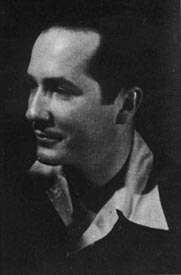|
- Stranger in a Strange Land (1961) - The Moon is a Harsh Mistress (1966) Priče: Nagrade:
|
| Robert
A. Heinlein
Robert Anson Heinlein je rođen 7. jula, 1907, a umro je u snu, jutra 8. maja 1988. godine.
Heinleinov rad posedovao je tri kvaliteta neophodna za dobar SF: dobro zamišljene zaplete, uvrljive likove i dobre naučne argumente. Bio je naučno precizan (tamo gde je nauka uspavala da prati njegovu maštu), a čak su i njegove fantastične priče imale logičku strukturu naučne fantastike. Mešao je tvrd i mek SF i fantastiku u raznim dozama, pokazujući da može da stvori dobre priče u bilo kojoj oblasti spekulativne fikcije (kako je definisao ono što piše). One of his major contributions to the genre was to bring into SF some of those sciences which until then had been practically ignored: administration, politics, economics, sociology, linguistics, mathematics, genetics, parapsychology and others; transforming his work into a precursor of New Wave SF. His writing style, showing most of the context through dialogue rather than narration, and permitting his characters to act and speak like real persons and not like characters from books, lent more verisimilitude to SF stories and was and is copied by many other authors. He also made it part of his style to use situations that he and his acquaintances had really experienced. Throughout the Fifties, Heinlein worked on Stranger in a Strange Land, which would become his best-known and probably greatest novel. In it, Heinlein satirized prevailing sexual,
religious and political attitudes; in other words, all of Western
society's structure. Many believe that this novel was the
consequence of the social unrest of the 60s, but what happened was
precisely the opposite; in 1960 the book was already ready for
publication. Heinlein, always attentive to society's trends, was a
step ahead of it in the liberation from and questioning of customs
that would soon follow. Hippie culture adopted Stranger in a Strange
Land as their guidebook. Heinlein became a national celebrity. After the incredible and unexpected success of Stranger in a Strange Land (it became the best-selling book in SF history), editors no longer dared reject or cut Heinlein's material; what he wrote sold--and all's well that sells well. Heinlein took advantage of this new-found freedom to write the books that he really wanted to write, without worrying about editors' tastes. He revisited his Future History universe and described to us the "lives" and loves of Lazarus Long (perhaps most prominent of cult-figure characters among Heinlein's fans) in Time Enough for Love (1973). He "invented" inter-universe travel and the concept of "World-as-Myth" (each fictional universe runs parallel to and is as real as our own, and our own universe is a fiction created by an author from another universe). These concepts allowed the meeting of characters from several of his books (universes) and from those of other authors in the novel Number of the Beast (1980). Heinlein analyzed the consequences of these concepts in his last two books: The Cat Who Walks through Walls (1985), and To Sail beyond the Sunset (1987). Heinlein was the first modern SF writer to live exclusively from the sale of his stories, the first to publish SF in large-circulation magazines not specialized in the genre, and the first to turn SF books into bestsellers, even among non-fans. He was, without a doubt, the writer who most influenced modern SF. Još neke knjige: |
 Svakako
jedan od trojice velikana SF-a (zajedno sa Asimovom i Clarkeom),
osvojio je nagrade Hugo za najbolji roman sa knjigama Double Star
'56; Starship Troopers '60; Stranger in a
Strange Land '62 i The Moon is a Harsh Mistress '67.
Svakako
jedan od trojice velikana SF-a (zajedno sa Asimovom i Clarkeom),
osvojio je nagrade Hugo za najbolji roman sa knjigama Double Star
'56; Starship Troopers '60; Stranger in a
Strange Land '62 i The Moon is a Harsh Mistress '67.